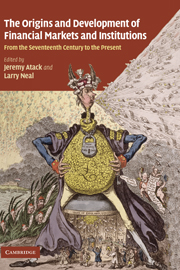 The Origins and Development of Financial Markets and Institutions
The Origins and Development of Financial Markets and Institutions Book contents
- Frontmatter
- Contents
- List of figures
- List of tables
- List of contributors
- Preface and acknowledgments
- 1 Financial innovations and crises: The view backwards from Northern Rock
- 2 An economic explanation of the early Bank of Amsterdam, debasement, bills of exchange and the emergence of the first central bank
- 3 With a view to hold: The emergence of institutional investors on the Amsterdam securities market during the seventeenth and eighteenth centuries
- 4 Was John Law's System a bubble? The Mississippi Bubble revisited
- 5 Sir George Caswall vs. the Duke of Portland: Financial contracts and litigation in the wake of the South Sea Bubble
- 6 The bell jar: Commercial interest rates between two revolutions, 1688–1789
- 7 Comparing the UK and US financial systems, 1790–1830
- 8 Natural experiments in financial reform in the nineteenth century: The Davis and Gallman analysis
- 9 Regulatory changes and the development of the US banking market, 1870–1914: A study of profit rates and risk in national banks
- 10 Anticipating the stock market crash of 1929: The view from the floor of the stock exchange
- 11 The development of “non-traditional” open market operations: Lessons from FDR's silver purchase program
- 12 The interwar shocks to US–Cuban trade relations: A view through sugar company stock price data
- 13 Central bank reaction functions during the inter-war gold standard: A view from the periphery
- 14 When do stock market booms occur? The macroeconomic and policy environments of twentieth century booms
- 15 Lessons from history for the twenty-first century
- Index
- References
10 - Anticipating the stock market crash of 1929: The view from the floor of the stock exchange
Published online by Cambridge University Press: 04 August 2010
- Frontmatter
- Contents
- List of figures
- List of tables
- List of contributors
- Preface and acknowledgments
- 1 Financial innovations and crises: The view backwards from Northern Rock
- 2 An economic explanation of the early Bank of Amsterdam, debasement, bills of exchange and the emergence of the first central bank
- 3 With a view to hold: The emergence of institutional investors on the Amsterdam securities market during the seventeenth and eighteenth centuries
- 4 Was John Law's System a bubble? The Mississippi Bubble revisited
- 5 Sir George Caswall vs. the Duke of Portland: Financial contracts and litigation in the wake of the South Sea Bubble
- 6 The bell jar: Commercial interest rates between two revolutions, 1688–1789
- 7 Comparing the UK and US financial systems, 1790–1830
- 8 Natural experiments in financial reform in the nineteenth century: The Davis and Gallman analysis
- 9 Regulatory changes and the development of the US banking market, 1870–1914: A study of profit rates and risk in national banks
- 10 Anticipating the stock market crash of 1929: The view from the floor of the stock exchange
- 11 The development of “non-traditional” open market operations: Lessons from FDR's silver purchase program
- 12 The interwar shocks to US–Cuban trade relations: A view through sugar company stock price data
- 13 Central bank reaction functions during the inter-war gold standard: A view from the periphery
- 14 When do stock market booms occur? The macroeconomic and policy environments of twentieth century booms
- 15 Lessons from history for the twenty-first century
- Index
- References
Summary
On October 3, 1929, John D. Rockefeller sold his right to one-quarter of a new seat on the New York Stock Exchange for $125,000. Only a few days before, on September 26, 1929, J.P. Morgan and Junius S. Morgan, Jr. had sold their rights for the same price. These represented the highest real price that would ever be paid for a seat on the exchange. Like other members of the exchange, Rockefeller and the Morgans had received these rights on February 18, 1929, as part of a plan to expand the capacity of the exchange and meet the flood of orders that flowed from the stock market boom. While not active brokers, they, like at least another hundred wealthy men, reserved the option to appear on the floor of the exchange to intervene directly in the market if a merger, proxy fight or perhaps a panic loomed. These titans of industry and finance could have sold their rights at any time beforehand, but they had held on to them. Their sales seem to have been extraordinarily well-timed. The Dow Jones had reached its peak on September 3, 1929, and then began a slow decline. Rockefeller and the Morgans sold as the boom deflated and just ahead of the collapses on Black Thursday October 24 and Black Tuesday October 29, 1929, when the market lost 23 percent of its value.
- Type
- Chapter
- Information
- The Origins and Development of Financial Markets and InstitutionsFrom the Seventeenth Century to the Present, pp. 294 - 318Publisher: Cambridge University PressPrint publication year: 2009
References
- 1
- Cited by


